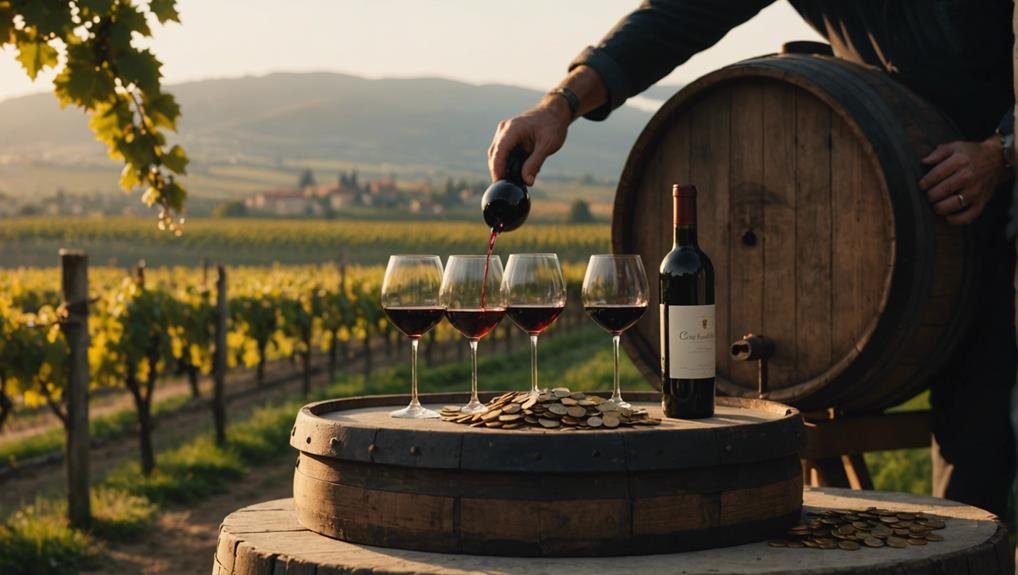Understanding wine prices involves recognizing various tiers, from budget-friendly to ultra-premium. Value wines, priced between $4 to $10, offer good quality at a low cost. Popular Premium wines in the $10 to $15 range satisfy general consumer tastes. Mid-range options, costing $15 to $50, strike a balance between quality and affordability. Premium wines, priced from $50 to $200, and ultra-premium wines costing over $200, often showcase superior craftsmanship and rarity.
Factors like production methods, region, and branding heavily influence wine prices. For instance, a Napa Valley Cabernet Sauvignon may cost more than a similar wine from a lesser-known region. Yet, hidden gems from places like Slovenia and Uruguay can offer unique flavors and excellent value.
Understanding these details helps you make informed choices. For example, if you enjoy a bold red, try a Malbec from Argentina, which often provides great quality at a reasonable price. Exploring different regions and price points can uncover the true value behind each bottle, making your wine selection more enjoyable and rewarding.
Curious for more insights?
Wine Pricing Segmentation
Understanding wine pricing segmentation can help us make smarter buying choices. Market trends and consumer preferences reveal a clear structure in wine pricing, ranging from Extreme Value to Super-Premium.
Each tier reflects a different level of investment and consumer expectation. For example, Value Wines, priced between $4 and $10, offer affordability while maintaining decent quality. Popular Premium wines, which cost between $10 and $15, better match typical consumer tastes.
Recognizing these tiers helps us navigate the wine market more effectively, ensuring we get the best value for our money.
If you're on a budget, consider brands like Barefoot or Yellow Tail for Value Wines. They provide good quality without breaking the bank. For Popular Premium wines, labels such as Kendall-Jackson or La Crema offer a more refined taste that aligns well with consumer preferences.
Price Ranges and Quality
Understanding the relationship between price ranges and wine quality can help us make smarter buying decisions. Budget-friendly wines, priced between $5 and $15, can sometimes surprise us in blind tastings by outperforming more expensive options. For example, a $10 bottle of Yellow Tail Shiraz might be just as enjoyable as a pricier alternative.
Mid-range wines, which fall between $15 and $50, often strike a good balance between quality and affordability. A $30 bottle of Kendall-Jackson Vintner's Reserve Chardonnay is a great example of this balance. These wines are often produced with better grapes and more attention to detail, offering a richer experience without breaking the bank.
Premium wines, ranging from $50 to $200, and ultra-premium wines, which cost $200 and above, are usually crafted with more care and higher quality ingredients. For instance, a $150 bottle of Opus One can offer a complex and refined taste. However, the higher price doesn't always mean better flavor. What truly matters is your personal preference and taste.
Using wine ratings and reviews can help you find great wines in any price range. Websites like Wine Enthusiast and Wine Spectator offer detailed reviews that can guide your choices. Ultimately, it's about finding wines you enjoy, regardless of their price.
Blind tasting is a fun way to explore wines without bias and discover what you genuinely like.
Factors Influencing Prices

Several key factors significantly impact wine prices, influencing our choices and enjoyment. First, the region where the wine is produced is crucial. Wines from famous regions like Bordeaux or Napa Valley are often more expensive because of their prestigious reputations and perfect grape-growing conditions.
Production methods also matter a lot. For example, hand-harvesting, organic farming, and long aging processes can increase costs. Wines made in small batches or with rare grape varieties are pricier due to their exclusivity.
Additionally, the age of the wine and the reputation of the brand contribute to its price.
Understanding these factors helps us make smarter choices that match our tastes and budgets.
Hidden Gems
Discovering lesser-known wines can change our drinking experience without emptying our wallets. By looking into new regions and small wineries, we can find amazing wines that offer great value.
These small producers often make unique wines with distinct flavors that reflect their local environment and innovative methods. For example, Slovenia and Uruguay are now making high-quality wines without the high prices of more famous regions.
Small wineries, with their limited production, focus on quality, allowing us to enjoy carefully made wines. By finding these hidden gems, we not only broaden our tastes but also support dedicated winemakers.
Wine Categories

When exploring wine categories, we find that each level—from Extreme Value to Premium—offers unique characteristics and enjoyment opportunities. In the Extreme Value range, wines are mass-produced and often blend multiple varietals, resulting in simple tasting notes.
Moving to Value wines, we encounter varietal selections from larger regions, offering more defined flavors and better palatability.
Popular Premium wines, priced at $10-$15, start to show specific traits, especially in unoaked whites like Sauvignon Blanc or Pinot Grigio. Premium wines, costing $15-$20, highlight terroir and specific characteristics, with red wines often oak-aged and hand-harvested.
Each category offers a distinct experience, making our choice not just about price but about appreciating what each tier adds to our wine journey.
Conclusion
Discovering Wine Prices: Finding True Value
We've explored the world of wine pricing, learning how to find quality bottles without spending too much. By understanding different price ranges and what affects costs, we can spot great wines at good prices.
It's important to know that personal taste matters as much as the label. Whether you're buying a budget-friendly wine or a top-tier bottle, making smart choices can bring joy and satisfaction.
For example, the Bogle Vineyards Old Vine Zinfandel offers excellent quality at an affordable price, while the Stags' Leap Napa Valley Cabernet Sauvignon is a fantastic option in the higher price range.
Cheers to making purchases that bring happiness and value!